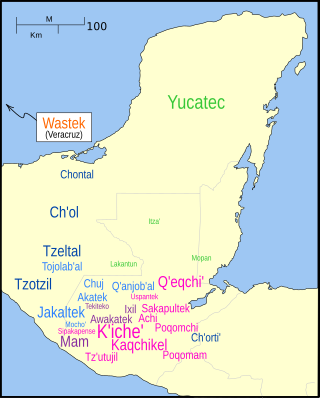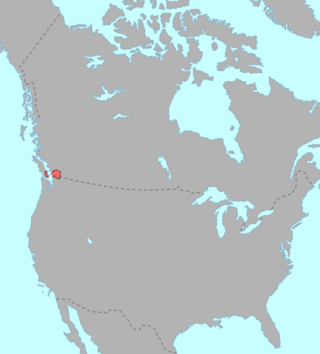Related Research Articles
A grammatical case is a category of nouns and noun modifiers which corresponds to one or more potential grammatical functions for a nominal group in a wording. In various languages, nominal groups consisting of a noun and its modifiers belong to one of a few such categories. For instance, in English, one says I see them and they see me: the nominative pronouns I/they represent the perceiver and the accusative pronouns me/them represent the phenomenon perceived. Here, nominative and accusative are cases, that is, categories of pronouns corresponding to the functions they have in representation.

Madí—also known as Jamamadí after one of its dialects, and also Kapaná or Kanamanti (Canamanti)—is an Arawan language spoken by about 1,000 Jamamadi, Banawá, and Jarawara people scattered over Amazonas, Brazil.

Greenlandic is an Eskimo–Aleut language with about 57,000 speakers, mostly Greenlandic Inuit in Greenland. It is closely related to the Inuit languages in Canada such as Inuktitut. It is the most widely spoken Eskimo–Aleut language.

Tzeltal or Tseltal is a Mayan language spoken in the Mexican state of Chiapas, mostly in the municipalities of Ocosingo, Altamirano, Huixtán, Tenejapa, Yajalón, Chanal, Sitalá, Amatenango del Valle, Socoltenango, Las Rosas, Chilón, San Juan Cancuc, San Cristóbal de las Casas and Oxchuc. Tzeltal is one of many Mayan languages spoken near this eastern region of Chiapas, including Tzotzil, Chʼol, and Tojolabʼal, among others. There is also a small Tzeltal diaspora in other parts of Mexico and the United States, primarily as a result of unfavorable economic conditions in Chiapas.
In linguistics, a word stem is a part of a word responsible for its lexical meaning. The term is used with slightly different meanings depending on the morphology of the language in question. In Athabaskan linguistics, for example, a verb stem is a root that cannot appear on its own and that carries the tone of the word. Athabaskan verbs typically have two stems in this analysis, each preceded by prefixes.

Halkomelem is a language of various First Nations peoples of the British Columbia Coast. It is spoken in what is now British Columbia, ranging from southeastern Vancouver Island from the west shore of Saanich Inlet northward beyond Gabriola Island and Nanaimo to Nanoose Bay and including the Lower Mainland from the Fraser River Delta upriver to Harrison Lake and the lower boundary of the Fraser Canyon.
Wiyot or Soulatluk (lit. 'your jaw') is an Algic language spoken by the Wiyot people of Humboldt Bay, California. The language's last native speaker, Della Prince, died in 1962.

The Wariʼ language is the sole remaining vibrant language of the Chapacuran language family of the Brazilian–Bolivian border region of the Amazon. It has about 2,700 speakers, also called Wariʼ, who live along tributaries of the Pacaas Novos river in Western Brazil. The word wariʼ means "we!" in the Wariʼ language and is the term given to the language and tribe by its speakers.

Yidiny is a nearly extinct Australian Aboriginal language, spoken by the Yidinji people of north-east Queensland. Its traditional language region is within the local government areas of Cairns Region and Tablelands Region, in such localities as Cairns, Gordonvale, and the Mulgrave River, and the southern part of the Atherton Tableland including Atherton and Kairi.
Tübatulabal is an extinct Uto-Aztecan language, traditionally spoken in Kern County, California, United States. It is the traditional language of the Tübatulabal, who have now shifted to English. The language originally had three main dialects: Bakalanchi, Pakanapul and Palegawan.
While other word categories in Ilocano are not as diverse in forms, verbs are morphologically complex inflecting chiefly for aspect. Ilocano verbs can also be cast in any one of five foci or triggers. In turn, these foci can inflect for different grammatical moods.

Wagiman, also spelt Wageman, Wakiman, Wogeman, and other variants, is a near-extinct Aboriginal Australian language spoken by a small number of Wagiman people in and around Pine Creek, in the Katherine Region of the Northern Territory.
Central Alaskan Yupʼik is one of the languages of the Yupik family, in turn a member of the Eskimo–Aleut language group, spoken in western and southwestern Alaska. Both in ethnic population and in number of speakers, the Central Alaskan Yupik people form the largest group among Alaska Natives. As of 2010 Yupʼik was, after Navajo, the second most spoken aboriginal language in the United States. Yupʼik should not be confused with the related language Central Siberian Yupik spoken in Chukotka and St. Lawrence Island, nor Naukan Yupik likewise spoken in Chukotka.

Lardil, also spelled Leerdil or Leertil, is a moribund language spoken by the Lardil people on Mornington Island (Kunhanha), in the Wellesley Islands of Queensland in northern Australia. Lardil is unusual among Aboriginal Australian languages in that it features a ceremonial register, called Damin. Damin is regarded by Lardil-speakers as a separate language and has the only phonological system outside Africa to use click consonants.

In linguistic morphology, inflection is a process of word formation in which a word is modified to express different grammatical categories such as tense, case, voice, aspect, person, number, gender, mood, animacy, and definiteness. The inflection of verbs is called conjugation, and one can refer to the inflection of nouns, adjectives, adverbs, pronouns, determiners, participles, prepositions and postpositions, numerals, articles, etc., as declension.
Jingulu, also spelt Djingili, is an Australian language spoken by the Jingili people in the Northern Territory of Australia, historically around the township of Elliot. The language is one of several languages of the West Barkly family.
Tommo So is a language spoken in the eastern part of Mali's Mopti Region. It is placed under the Dogon language family, a subfamily of the Niger-Congo language family.
Martu Wangka, or Wangkatjunga (Wangkajunga), is a variety of the Western Desert language that emerged during the 20th century in Western Australia as several indigenous communities shifted from their respective territories to form a single community. Traditionally, its speakers live in territory that is part of the Great Sandy Desert and near the Canning Stock Route, as well as Christmas Creek and Fitzroy Crossing. These are areas that are considered deserts but have many water holes that speakers travel between. There are an estimated 1,080 speakers of Martu Wangka in various communities across the Western Desert region. The largest of these communities is estimated at 100 speakers, while some of the smallest communities have as few as 15 speakers. While older speakers continue to use Martu Wangka as their primary language, younger speakers tend to understand Martu Wangka but use different languages in their daily lives. For example, many younger speakers primarily use an English-based creole commonly referred to as the Fitzroy Valley Kriol.
Bilingara, also known as the Bilinarra, is an Australian Aboriginal language spoken by the Bilinarra people of the Northern Territory.
This article describes the grammar of the Old Irish language. The grammar of the language has been described with exhaustive detail by various authors, including Thurneysen, Binchy and Bergin, McCone, O'Connell, Stifter, among many others.
References
- ↑ Australian Bureau of Statistics (2021). "Cultural diversity: Census" . Retrieved 13 October 2022.
- ↑ K15 Bardi at the Australian Indigenous Languages Database, Australian Institute of Aboriginal and Torres Strait Islander Studies
- ↑ Bowern 2012, pp. 1, 5, 25–26, 28.
- ↑ McKenzie, Vincent (13 August 2019). "Education is the key to keeping Bardi language and culture strong". Life. Australian Broadcasting Corporation. Retrieved 11 November 2019.
- ↑ "Curriculum". Christ the King Catholic School. Retrieved 11 November 2019.
- ↑ Bowern 2012, p. 9.
- ↑ Bowern 2012, p. 15.
- ↑ Bowern 2012, p. 703.
- ↑ Bowern 2012.
- ↑ Bowern 2012, pp. 71–100.
- ↑ Bowern 2012, p. 100.
- ↑ Bowern 2012, pp. 110–112.
- ↑ Bowern 2012, p. 151.
- ↑ Bowern 2012, p. 179.
- ↑ Bowern 2012, p. 172.
- 1 2 Bowern 2012, p. 181.
- ↑ Bowern 2012, p. 174.
- 1 2 Bowern 2012, p. 187.
- 1 2 Bowern 2012, p. 192.
- ↑ Bowern 2012, p. 361.
- ↑ Bowern 2012, p. 362.
- ↑ Bowern 2012, p. 372.
- ↑ Bowern 2012, p. 136.
- 1 2 Bowern 2012, p. 257.
- 1 2 Bowern 2012, p. 592.
- ↑ Bowern 2012, pp. 592–598.
- Bowern, Claire (2012). A Grammar of Bardi. Berlin/Boston: De Gruyter, Inc. ISBN 9783110278156.
- Aklif, G. (1999). Ardiyooloon Bardi Ngaanka, One Arm Point Bardi dictionary. Halls Creek, Western Australia: Kimberley Language Resource Centre.
- Dixon, R. M. W. (2002). Australian Languages: Their Nature and Development. Cambridge: Cambridge University Press.